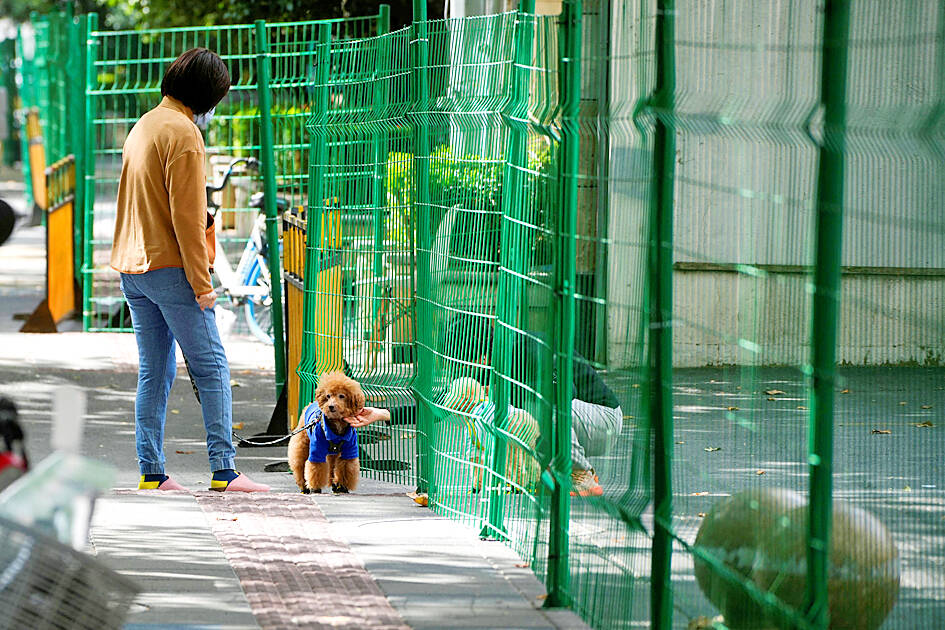Shanghai and other big Chinese cities, including Shenzhen, have ramped up testing for COVID-19 as infections rise, with some local authorities hastily closing schools, entertainment venues and tourist spots.
Infections have risen to the highest since August, with the uptick coming after increased domestic travel during China’s seven-day National Day holiday earlier this month.
Authorities reported 2,089 new local infections for Monday yesterday, the most since Aug. 20.

Photo: Reuters
While many of the cases were found in tourist destinations, including scenic spots in the northern region of Inner Mongolia, megacities that are often the source of well-heeled and well-traveled tourists have started to report more cases this week.
Shanghai, China’s financial capital of 25 million people, reported 28 local cases for Oct. 10, the fourth day of double-digit increases.
Keen to avoid a reprise of the economically and psychically scarring lockdown in April and May, Shanghai said late on Monday that all of its 16 districts were to conduct routine testing at least twice a week until Nov. 10.
That is a step up from once a week, a regime imposed after the last lockdown.
Checks on inbound travelers and in places such as hotels should also be bolstered, authorities said.
The expanding web of measures have already ensnared some.
Peter Lee, a long-time British expatriate, was out at lunch with his wife and seven-year-old son last week when he was notified his apartment block was to be locked down for 48 hours.
Lee and his son checked into a hotel, which was then also locked down due to a prior visit by a COVID-19 case.
Lee’s wife, who was planning to join them, had no choice but returned home to be locked in, and then had her lockdown extended.
Lee and his son are due to be released tomorrow, while Lee’s wife is not to be released until Sunday.
“It might be that we say, we miss home and we miss mum too much and maybe we just go home and just deal with it, but we also lose another weekend then,” Lee said. “We’re monitoring the situation, because it seems like Shanghai is gradually shutting down anyway, and if everything starts to close then there won’t be much benefit in being able to come and go.”
As of Monday, 36 Chinese cities were under various degrees of lockdown or control, affecting abotu 196.9 million people, versus 179.7 million in the previous week, Nomura Holdings said.
In China’s southern tech hub of Shenzhen, where the highly transmissible Omicron BF.7 subvariant of SARS-CoV-2 has surfaced, local cases more than tripled to 33 on Monday from a day earlier.
Inbound travelers are to be subject to three tests over three days, authorities in the city of 18 million people said yesterday.
Despite China’s very small caseload versus the rest of the world, and the toll its counter-epidemic policies exact on the economy and population, the government has repeatedly urged people to accept the measures.
“Once a large-scale rebound occurs, the epidemic will spread, and is bound to have a serious impact on economic and social development, and the final price will be higher and losses will be greater,” the state-controlled People’s Daily wrote in a commentary yesterday.
The COVID-19 preventive steps come days ahead of a Chinese Communist Party National Congress starting on Sunday where Chinese President Xi Jinping (習近平) is expected to extend his leadership.

A fire caused by a burst gas pipe yesterday spread to several homes and sent a fireball soaring into the sky outside Malaysia’s largest city, injuring more than 100 people. The towering inferno near a gas station in Putra Heights outside Kuala Lumpur was visible for kilometers and lasted for several hours. It happened during a public holiday as Muslims, who are the majority in Malaysia, celebrate the second day of Eid al-Fitr. National oil company Petronas said the fire started at one of its gas pipelines at 8:10am and the affected pipeline was later isolated. Disaster management officials said shutting the

US Vice President J.D. Vance on Friday accused Denmark of not having done enough to protect Greenland, when he visited the strategically placed and resource-rich Danish territory coveted by US President Donald Trump. Vance made his comment during a trip to the Pituffik Space Base in northwestern Greenland, a visit viewed by Copenhagen and Nuuk as a provocation. “Our message to Denmark is very simple: You have not done a good job by the people of Greenland,” Vance told a news conference. “You have under-invested in the people of Greenland, and you have under-invested in the security architecture of this

UNREST: The authorities in Turkey arrested 13 Turkish journalists in five days, deported a BBC correspondent and on Thursday arrested a reporter from Sweden Waving flags and chanting slogans, many hundreds of thousands of anti-government demonstrators on Saturday rallied in Istanbul, Turkey, in defence of democracy after the arrest of Istanbul Mayor Ekrem Imamoglu which sparked Turkey’s worst street unrest in more than a decade. Under a cloudless blue sky, vast crowds gathered in Maltepe on the Asian side of Turkey’s biggest city on the eve of the Eid al-Fitr celebration which started yesterday, marking the end of Ramadan. Ozgur Ozel, chairman of the main opposition Republican People’s Party (CHP), which organized the rally, said there were 2.2 million people in the crowd, but

JOINT EFFORTS: The three countries have been strengthening an alliance and pressing efforts to bolster deterrence against Beijing’s assertiveness in the South China Sea The US, Japan and the Philippines on Friday staged joint naval drills to boost crisis readiness off a disputed South China Sea shoal as a Chinese military ship kept watch from a distance. The Chinese frigate attempted to get closer to the waters, where the warships and aircraft from the three allied countries were undertaking maneuvers off the Scarborough Shoal — also known as Huangyan Island (黃岩島) and claimed by Taiwan and China — in an unsettling moment but it was warned by a Philippine frigate by radio and kept away. “There was a time when they attempted to maneuver